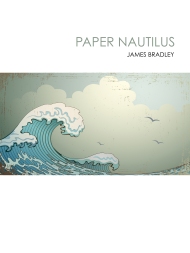Micheline Jenner, The Secret Life of Whales, Eelco Rohling, The Oceans: A Deep History and Jeff Goodell, The Water Will Come: Rising Seas, Sinking Cities and the Remaking of the Civilised World
 In The Sea Around Us, her luminous 1951 exploration of the world’s oceans, Rachel Carson sought to understand the human fascination with her subject, imagining the first humans to encounter its immensity. “Standing on its shores,” she wrote, “he must have looked out upon it with wonder and curiosity, compounded with an unconscious recognition of his lineage. He could not physically re-enter the ocean as the seals and whales had done. But over the centuries, with all the skill and ingenuity and reasoning powers of his mind, he has sought to explore and investigate even its most remote parts, so that he might re-enter it mentally and imaginatively.”
In The Sea Around Us, her luminous 1951 exploration of the world’s oceans, Rachel Carson sought to understand the human fascination with her subject, imagining the first humans to encounter its immensity. “Standing on its shores,” she wrote, “he must have looked out upon it with wonder and curiosity, compounded with an unconscious recognition of his lineage. He could not physically re-enter the ocean as the seals and whales had done. But over the centuries, with all the skill and ingenuity and reasoning powers of his mind, he has sought to explore and investigate even its most remote parts, so that he might re-enter it mentally and imaginatively.”
Carson’s lyricism and sense of hushed sublimity is, of course, a product of its time and place, suffused by the Romanticism that has pervaded American nature writing since Thoreau. Certainly one does not have to look far to find other, less exalted attitudes to the sea and its dangers.
Yet while human attitudes to the ocean have taken many forms, there is, as oceanographer and Professor of Ocean and Climate Change at the Australian National University Eelco J. Rohling observes, no question our relationship with the ocean is almost as ancient as we are. Middens scatter the world’s coastlines, testament to our exploitation of the ocean’s resources, and not only must the ancestors of Australia’s Aborigines have developed watercraft capable of deep ocean passages at least 50,000 years ago in order to navigate the Indonesian Archipelago, it is probable these technologies existed even earlier in order to enable humans to cross the Red Sea on their way out of Africa (nor were we alone in this: although Rohling does not mention it, the supposedly primitive Homo Erectus, ancestor of Flores’ hobbits, must have made a similar passage through Indonesia, while our cousins, the Neanderthals, were crafting jewellery from shells at least 50,000 years ago).
 Across the hundreds of centuries since humans left Africa the oceans have continued to shape our societies, providing resources, both economic and cultural (after animals the ocean is surely one of our richest sources of myth and metaphor), enabling travel and conquest and driving technological innovation. Simultaneously their effects on climate and geography have had a profound impact on our history, driving the rise and fall of civilizations by altering rainfall patterns and drowning entire cultures as glaciers melted at the end of the last Ice Age.
Across the hundreds of centuries since humans left Africa the oceans have continued to shape our societies, providing resources, both economic and cultural (after animals the ocean is surely one of our richest sources of myth and metaphor), enabling travel and conquest and driving technological innovation. Simultaneously their effects on climate and geography have had a profound impact on our history, driving the rise and fall of civilizations by altering rainfall patterns and drowning entire cultures as glaciers melted at the end of the last Ice Age.
For much of our history this relationship was mostly one way. Yet over the past 150 years the human impact on the ocean has grown ever more profound. Industrial whaling, overfishing, pollution and the many-pronged effects of rising global temperatures (in particular what Rohling describes as the “silent killer”, ocean acidification) have pushed many marine environments to the brink of collapse or beyond, a process that is only accelerating as human population and consumption continues to rise.
Rohling’s book seeks to emphasise the perils of our failure to understand that not only are the oceans not limitless, or the degree to which, to borrow American historian Will Durant’s famous formulation, “civilization exists by geologic consent – subject to change without notice.” To achieve this Rohling offers a geologic perspective, exploring the origins and development of the Earth’s oceans from their origins to the present day.
His account moves from the Earth’s formation and the mystery of where the oceans came from (until the European space probe Philae landed on Comet Curyumov-Gerasimenko in 2015 it was assumed most of the water on Earth was deposited from space around four billion years ago in a process called the Late Heavy Bombardment, a hypothesis made untenable by differences in the isotopic composition of the water on Curyumov-Gerasimenko and Earth) through the emergence and development of life, exploring tectonics, currents and other large scale oceanic processes, as well as the cycles of warming and cooling driven by biological and planetary factors.
The results are genuinely exciting, even if they do prompt questions about who exactly the book is aimed at. In contrast to most popular science The Oceansavoids journalistic emphasis upon personalities or historical narrative, focussing instead upon the actual science, and meaning the book sometimes reads more like a textbook than a work aimed at the general reader. In the wrong hands that could result a work that is dry (if you’ll pardon the pun) or overly technical, but in fact the density of information and Rohling’s clear, concise explanations make for exhilarating reading, not least because Rohling’s delight in his subject matter is so palpable.
Most importantly though, Rohling’s long view makes clear the enormity of the transformation of the oceans taking place around us, underlining not just the effect of ecosystems and biodiversity, but also its geological scale.
Amidst the rising tide of awful news about the planet’s oceans, the resurgence of global whale populations is a rare good news story. Despite the growing threats facing certain populations – the Baiji, or Yangtze River Dolphin is believed to be functionally extinct, the Vaquita and Maui’s Dolphin are both critically endangered, and as warming waters drive Northern Right Whales northward they seem to be dying in increasing numbers – many whale species have rebounded spectacularly in the three decades since commercial whaling ended.
Having started studying humpback whales in the Pilbara in 1990, Australian marine scientists Micheline and Curt Jenner have observed this phenomenon first hand, a process Micheline Jenner documents in her memoir, The Secret Life of Whales. Beginning with a decade observing humpback whales off the Kimberley and Pilbara in Western Australia, they have spent time studying pygmy blue whales in the Perth Canyon, more than 70km west of Fremantle, studied dolphins along the Western Australian coast and Minke Whales on the Great Barrier Reef, and travelled to Antarctica in order to better understand the migratory behaviour of humpbacks.
Jenner’s account of her life is exultant, lit both by her endless wonder at her subjects’ magnificence and her own immense good fortune to have been able to spend a good portion of her life observing them at close quarters. And while there are times one wishes she would dial the positivity down a little – I could have done with a few less cries of “How lucky are we!” – the book offers a delightfully human portrait of life as a working naturalist and a fascinating glimpse into the complexity and mystery of the whales she loves.
Perhaps predictably many of the book’s best stories involve mishaps of one sort or another, most notably hilariously disgusting descriptions of being caught in blasts of whale mucus or covered in reeking orange whale poo (an experience that led to an important discovery about the behaviour of pygmy blue whales). Likewise Jenner’s discussion of the physiology of her subjects is always interesting, whether she is detailing the huge volumes of milk consumed by baby humpbacks (a nursing humpback mother produces 200-300 litres of milk a day, and because they do not feed during their northern migration, will lose 3600-4500 kilograms while caring for their calf) or talking about sperm whales diving up to three kilometres deep in search of food. Yet the book’s most fascinating moments are those relating to the behaviour of the whales, and in particular the evidence of complex behaviour and bonding, whether in the form of maternal commitment, altruism or grief, questions Jenner alludes to but does not pursue.
As Jenner points out toward her book’s end, many whale populations are threatened by climate change, and its potential to disrupt the life cycle of the krill upon which many whales depend (Rohling similarly points to fascinating research suggesting whales play a pivotal part in fertilising the world’s oceans, and that the decline in fish stocks may be at least partly attributable to the depletion of whale numbers from the early 1800s on).
 Sadly though, for most of us these problems are essentially abstract, stories about the plight of creatures we rarely see. Yet as Jeff Goodell’s The Water Will Comemakes terrifyingly clear, the threat posed by climate change is neither abstract nor a problem for the future: instead it is real and happening all around us.
Sadly though, for most of us these problems are essentially abstract, stories about the plight of creatures we rarely see. Yet as Jeff Goodell’s The Water Will Comemakes terrifyingly clear, the threat posed by climate change is neither abstract nor a problem for the future: instead it is real and happening all around us.
Goodell is a contributing editor at Rolling Stone, and along with The New Yorker’sElizabeth Kolbert has written some of the most intelligent and clear-eyed accounts of the politics and practical effects of rising global temperatures. In The Water Will Comehe brings these skills to bear on the most discussed but possibly least-understood dimension of climate change, rising sea levels.
As with many aspects of climate change, our capacity to effectively respond to the problem is limited by our inability to imagine its consequences. But in the case of sea level rise that problem is exacerbated by our lack of certainty around how far and how fast seas will rise.
As Goodell makes clear, this lack of certainty about how far sea levels will rise should not be confused with a lack of certainty about whether they will rise, or whether that rise will be significant. Even the absolute bottom end estimates suggest a 30cm rise by the end of the century, and many scientists now believe they are likely to rise considerably more: asked whether estimates of two metres by 2100 are too low one glaciologist responds simply, “Shit, yeah”.
There have been other books about these questions but Goodell’s account is undoubtedly one of the best, capturing not just the scale of the problem, but also, through interviews with politicians, architects, planners and real estate developers, its sheer complexity in both practical and political terms and the unequal distribution of effects between rich and poor.
Yet while one of the highlights of the book is its remarkable opening section, in which Goodell offers a chillingly plausible portrait of the destruction of Miami in a hurricane twenty years from now (a device he borrows from Carson’s seminal Silent Spring), the book’s real achievement lies in its clear-eyed assessment of the scale of the social and economic disruption that lies just over the horizon. For like Rohling, and to a lesser extent Jenner, Goodell recognises we inhabit a moment in which geological and human time scales have collapsed into each other, creating a situation where the fate of the human race and the fate of the planet are now interdependent. Or, as Rachel Carson put it more than half a century ago, “it is a curious situation that the sea, from which life first arose should now be threatened by the activities of one form of that life. But the sea, though changed in a sinister way, will continue to exist; the threat is rather to life itself.”
Originally published in The Weekend Australian, 9 February 2018.








